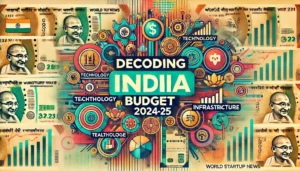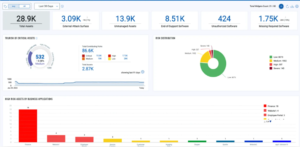India’s Budget 2024: A Comprehensive Review of Key Investments and Allocations

The Union Budget 2024-25, presented by Finance Minister Nirmala Sitharaman, marks a significant milestone in India’s economic planning.
This budget, her seventh consecutive presentation, comes amidst global economic uncertainties but showcases the resilience of India’s economy, with inflation moving towards a stable 4% and core inflation at 3.1%.
Let’s delve into the major investments and allocations detailed in this transformative budget, reflecting the government’s commitment to holistic development and economic growth.
But before that i would sincerely thank Governement for Removal of Angel Tax which is a Big Boost for Startups in India.
The “angel tax” refers to a tax levied on the capital raised by unlisted companies via the issue of shares, where the share price exceeds the fair market value of the shares. Introduced in 2012, this tax was aimed at curbing money laundering but had unintended negative consequences on startups.
Key Details of the Angel Tax Removal:
- Budget Announcement: The 2024-25 budget announced the complete removal of the angel tax for startups, eliminating the tax burden on investments made by angel investors.
- Impact on Startups: This change will encourage more investments in startups by reducing the tax liability on funds raised through angel investors. It will help startups access the capital they need to grow and scale their operations.
- Ease of Doing Business: The removal simplifies the process of raising funds, making it easier for startups to attract investment without the fear of additional tax scrutiny.
Implications for Different Sectors:
- Startups: Easier access to capital will drive innovation, allowing startups to invest in research and development, expand their teams, and scale their operations more effectively.
- Investors: Angel investors will be more inclined to invest in early-stage companies without the concern of an additional tax burden, leading to increased funding opportunities for startups.
- Economy: A thriving startup ecosystem will contribute to job creation, technological advancements, and overall economic growth, positioning India as a hub for innovation and entrepreneurship.
Development of Amaravati
In a move to bolster the infrastructure and economic landscape of Andhra Pradesh, Finance Minister Nirmala Sitharaman announced a substantial financial endowment of Rs. 15,000 crore for the development of Amaravati, the state’s nascent capital. This allocation is part of the current fiscal cycle, with assurances of additional funds in subsequent years. The announcement underscores the Central government’s recognition of Andhra Pradesh’s urgent need for capital infusion, although it notably did not include the Special Category Status (SCS) fervently sought by the state.
Polavaram Irrigation Project
Continuing the financial support for Andhra Pradesh, the Finance Minister reaffirmed the Central government’s unwavering commitment to the Polavaram irrigation project. Described as the lifeblood of Andhra Pradesh and its agrarians, this project is crucial for the state’s agricultural sector. The budget ensures sustained funding to complete the Polavaram project, fulfilling the promises made under the Andhra Pradesh Reorganization Act.
Vizag-Chennai Industrial Corridor
The advancement of the Vizag-Chennai industrial corridor was another highlight. The Finance Minister announced a specialized package for its enhancement, emphasizing the corridor’s role in boosting industrial growth and economic development in the region. The investment in this corridor aims to improve infrastructure, create jobs, and attract further investments, thereby fostering a robust industrial ecosystem.
Grants for Underdeveloped Regions
Recognizing the disparities in development within the state, the Finance Minister declared that grants would be allocated to underdeveloped regions such as Rayalaseema and coastal Andhra Pradesh. These grants are intended to propel various developmental initiatives, addressing the socio-economic challenges faced by these areas. This targeted approach aims to ensure balanced regional development and upliftment of underprivileged communities.
Purvodaya Scheme
The Purvodaya scheme, aimed at the holistic advancement of states including Bihar, Jharkhand, West Bengal, Odisha, and Andhra Pradesh, received a significant boost. This comprehensive scheme focuses on socio-economic development through infrastructure investments, job creation, and social welfare programs. By addressing the specific needs of these states, the scheme aims to reduce regional disparities and promote inclusive growth.
Union Budget 2024-25: Key Financial Metrics and Allocations
The Union Budget 2024-25 delineates an ambitious financial plan aimed at fostering economic stability and growth. Here are the critical financial metrics and allocations:
Receipts and Expenditure
The Revised Estimate of total receipts, excluding borrowings, is ₹32.07 lakh crore. The total expenditure is projected at ₹48.21 lakh crore. Notably, the government has retained ₹11.11 lakh crore for capital expenditure, maintaining the level set in the Interim Budget 2024-24 presented in February. This robust allocation underscores the government’s commitment to infrastructure development and economic resilience.
Where the Money Comes From
- Borrowings and Other Liabilities: The largest avenue, accounting for a significant portion of the budget revenue.
- Income Tax, GST, and Other Taxes: Major sources of revenue, reflecting the government’s reliance on tax collections.
- Corporation Tax: A substantial contributor to the budget’s income.
Where the Money Goes
- States’ Share of Taxes and Duties: The highest expenditure category, with 21% allocated to states’ shares.
- Central Sector Schemes and Other Expenditures: A large part of the budget, amounting to ₹30.07 lakh crore, is dedicated to central sector schemes and expenditures.
- Interest Payments: A significant portion of the expenditure, reflecting the costs of borrowing.
- Finance Commission Grants and Transfers to States: Essential for supporting state-level initiatives and ensuring balanced regional development.
State-wise Allocation of Central Taxes and Duties
The Union Government allocated ₹12,47,211.28 crores of Union taxes and duties to states. Uttar Pradesh receives the highest share at approximately 18%, amounting to ₹2,23,737.23 crores. This allocation is crucial for supporting state-level projects and ensuring equitable distribution of resources, fostering regional development.
Major Expenditures and Schemes
This year’s total budget expenditure amounts to ₹48.21 lakh crore. The allocations for major schemes driving socio-economic development include:
- Central Sector Scheme Expenditure: Involving economic services, general services, subsidies, social services, and others.
- Other Central Expenditure: Including interest payments and payments to autonomous bodies.
- Establishment Expenditure: Covering salaries, pensions, and other central government expenses.
- Finance Commission Grants and Transfers to States: Essential for balanced regional development and state-level projects.
Core Welfare Schemes Allocation
The Union Budget 2024-25 emphasizes core welfare schemes that are pivotal for socio-economic development. These include:
- Pradhan Mantri Awas Yojana (PMAY): Continued support for affordable housing initiatives.
- Pradhan Mantri Fasal Bima Yojana (PMFBY): Insurance schemes for farmers to mitigate the risks associated with farming.
- Mahatma Gandhi National Rural Employment Guarantee Act (MGNREGA): Ensuring rural employment and socio-economic stability.
- Pradhan Mantri Krishi Sinchayee Yojana (PMKSY): Investments in irrigation projects to support agriculture.

Investments in Infrastructure and Urban Development
The budget highlights substantial investments in infrastructure and urban development, aimed at enhancing connectivity and promoting urbanization:
- Smart Cities Mission: Continued investment in developing smart cities with advanced infrastructure and technology.
- Atal Mission for Rejuvenation and Urban Transformation (AMRUT): Focus on urban infrastructure, including water supply and sewerage.
- Bharatmala Pariyojana: Investments in road infrastructure to improve connectivity and reduce travel time.
- Sagarmala Project: Enhancing port infrastructure to boost maritime trade.
Energy Security and Innovation
The budget allocates significant funds for energy security and innovation, critical for sustainable development:
- Renewable Energy Projects: Investments in solar, wind, and other renewable energy sources.
- Research and Development: Funding for innovation and technology development to drive economic growth.
Social Justice and Job Creation
The budget also emphasizes social justice and job creation, ensuring inclusive growth:
- Scheduled Castes Sub Plan (SCSP) and Tribal Sub Plan (TSP): Allocations for the socio-economic development of SCs and STs.
- Skill India Mission: Investments in skill development programs to enhance employability.
1. Agriculture and Food Security
- Transforming Agriculture Research
- Budget Allocation: ₹1.52 lakh crore for agriculture and allied sectors.
- Comprehensive review to focus on productivity and climate-resilient crops.
- Funding in a challenge mode involving private sector participation.
- Release of New Varieties
- Introduction of 109 high-yielding, climate-resilient varieties of crops.
- Natural Farming Initiative
- One crore farmers to adopt natural farming practices over two years.
- Supported by certification and branding, facilitated by scientific institutions and gram panchayats.
- Establishment of 10,000 bio-input resource centres.
- Pulses and Oilseeds Mission
- Strengthening production, storage, and marketing to achieve self-sufficiency in pulses and oilseeds.
- Digital Public Infrastructure for Agriculture
- Expansion of digital crop surveys and farmer-land registries.
- Jan Samarth based Kisan Credit Cards to be issued in 5 states.
2. Employment and Skilling
- Prime Minister’s Employment Linked Incentive Schemes
- Budget Allocation: ₹2 lakh crore over 5 years.
- Scheme A: One-month wage subsidy (up to ₹15,000) for first-time employees in all formal sectors.
- Scheme B: Incentives for job creation in manufacturing, benefiting 30 lakh youth.
- Scheme C: Support to employers hiring additional employees, reimbursing up to ₹3,000 per month towards EPFO contributions.
- Participation of Women in the Workforce
- Setting up working women hostels and creches in collaboration with industry.
- Women-specific skilling programs and market access promotion for women SHG enterprises.
- Skilling Program
- Upgradation of 1,000 Industrial Training Institutes (ITIs) in hub and spoke arrangements.
- Loans up to ₹7.5 lakh for skilling programs, benefiting 25,000 students annually.
- Education Loans
- Financial support for loans up to ₹10 lakh for higher education in domestic institutions, with e-vouchers for interest subvention.
3. Inclusive Human Resource Development and Social Justice
- Purvodaya Initiative
- Budget Allocation: ₹2.66 lakh crore for rural development.
- Focused development of the Eastern region covering Bihar, Jharkhand, West Bengal, Odisha, and Andhra Pradesh.
- Projects include new power plants, road connectivity, airports, medical colleges, and sports infrastructure.
- Women-led Development
- Budget Allocation: More than ₹3 lakh crore for schemes benefiting women and girls.
- Promoting women-led development and enhancing women’s role in economic activities.
- PM Awas Yojana
- Announcement of three crore additional houses in rural and urban areas.
4. Energy Security and Green Initiatives
- PM Surya Ghar Muft Bijli Yojana
- Installation of rooftop solar plants to provide free electricity up to 300 units per month for one crore households.
- More than 1.28 crore registrations and 14 lakh applications received.
- Nuclear Energy Development
- Development of Bharat Small Modular Reactors in partnership with the private sector.
- Research and development funding for newer nuclear technologies.
- Pumped Storage Policy
- Promoting electricity storage through pumped storage projects to integrate renewable energy.
5. Infrastructure Development
- Infrastructure Investment
- Budget Allocation: ₹1.11 lakh crore for capital expenditure.
- Encouraging state governments to invest ₹1.5 lakh crore in long-term interest-free loans.
- Pradhan Mantri Gram Sadak Yojana (PMGSY) Phase IV
- Providing all-weather connectivity to 25,000 rural habitations.
- Flood Mitigation and Irrigation Projects
- Financial support for flood control structures and irrigation projects in Bihar, Assam, Himachal Pradesh, Uttarakhand, and Sikkim.
- Tourism Development
- Comprehensive development of Vishnupad Temple Corridor, Mahabodhi Temple Corridor, and Nalanda as major tourist centers.
Tax Rates and Reforms
- Personal Income Tax Rates (New Tax Regime)
- 0-3 lakh rupees: Nil
- 3-7 lakh rupees: 5%
- 7-10 lakh rupees: 10%
- 10-12 lakh rupees: 15%
- 12-15 lakh rupees: 20%
- Above 15 lakh rupees: 30%
- Standard Deduction
- Increased from ₹50,000 to ₹75,000 for salaried employees.
- Family pension deduction increased from ₹15,000 to ₹25,000.
- Corporate Tax Rate for Foreign Companies
- Reduced from 40% to 35% to attract foreign investment.
- Capital Gains Tax Simplification
- Short-term gains on certain financial assets taxed at 20%.
- Long-term gains on all assets taxed at 12.5%.
- Exemption limit for capital gains increased to ₹1.25 lakh per year.
- Goods and Services Tax (GST)
- Continued simplification and rationalization of the tax structure.
- Amendments to facilitate trade and expand GST benefits to more sectors.
Conclusion
Union Finance Minister Nirmala Sitharaman’s Budget 2024-25 is a comprehensive financial plan to foster economic growth, social justice, and sustainable development. With significant allocations for key projects and initiatives, the budget reflects the government’s commitment to holistic development and economic resilience. From the substantial endowment for Amaravati to the sustained support for the Polavaram project and the Purvodaya scheme, the budget lays the groundwork for a prosperous and inclusive future.
FAQs
What are the key highlights of the Union Budget 2024-25?
The key highlights include a substantial endowment for the development of Amaravati, sustained support for the Polavaram irrigation project, enhancement of the Vizag-Chennai industrial corridor, and significant allocations for core welfare schemes like PMAY and MGNREGA.
How does the budget address regional disparities?
The budget addresses regional disparities by allocating grants to underdeveloped regions such as Rayalaseema and coastal Andhra Pradesh. It also emphasizes the Purvodaya scheme, which focuses on the holistic development of states like Bihar, Jharkhand, West Bengal, Odisha, and Andhra Pradesh.
What are the major sources of revenue in the Union Budget 2024-25?
The major sources of revenue include borrowings and other liabilities, income tax, GST, other taxes, and corporation tax.
How much has been allocated for capital expenditure in the Union Budget 2024-25?
The Union Budget 2024-25 has allocated ₹11.11 lakh crore for capital expenditure, maintaining the level set in the Interim Budget 2024-24.
What are the significant investments in infrastructure and urban development?
Significant investments include the Smart Cities Mission, Atal Mission for Rejuvenation and Urban Transformation (AMRUT), Bharatmala Pariyojana, and the Sagarmala Project.
How does the budget promote energy security and innovation?
The budget promotes energy security and innovation through substantial investments in renewable energy projects and funding for research and development to drive economic growth.




